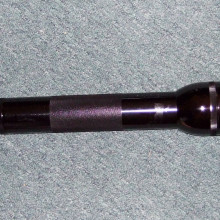Why don't you get thrown backwards when you switch on your torch? Kerstin Gopfrich made her way to the Nanophotonics Centre in Cambridge to find out from Dr. Anna Lombardi. The answer to Matt's question may blow you away...
In this episode

00:00 - Can light exert a force to move an object?
Can light exert a force to move an object?
Kerstin Geopfrich put this question to Dr Anna Lombardi from the University of Cambridge...
Kerstin - To shed light on this question I dug out my torch and made my way to the Nanophotonics Centre in Cambridge where I met with Dr Anna Lombardi.
Anna - can light exert a force to move a physical object? Anna - Yes, definitely. According the Newton's second law of motion, a force is the mass of an object times its acceleration. But light is weird, it travels at a constant speed, the speed of light and it never accelerates. In addition, light is made of photons which don't have any mass. The crucial point is that while light doesn't accelerate, and doesn't have mass, it does carry momentum and momentum, as a form of energy, can be transferred. By transferring their momentum, photons are able to exert a force on an object. Physicists refer to it as an optical force. The higher the frequency of the light, the larger its momentum and, therefore, a stronger force it can exert. This means that blue light will push you stronger than red light.
Kerstin - The theory tell us that light does have a little bit of a push but I certainly cannot feel it when I switch on my torch. What's the point of all the theory then?
Anna - While the push of light is so tiny that you don't feel it in everyday life, we can observe it at the nanoscale in the world of the infinitely small. Arthur Ashkin, a scientist working at the Bell Labs in the seventies demonstrated that nanometer and micron sized particles can be accelerated, trapped and manipulated by radiation pressure of a highly focused laser beam.
Nowadays, scientists use light quite literally like optical tweezers to manipulate objects from cells to single atoms
Kirsten - Does that mean that we just need a superpower torch to move the big stuff?
Anna - If as a light source we don't limit ourselves to a simple torch, but we consider the Sun, then the radiation pressure exerted is strong enough to push spacecrafts and even asteroids from their path.
Kirsten - So you'd better know the math when you plan your next mission to space. But Matt, I think we're safe to turn the torch back on. Thanks for your question and thank you Anna for the answer.










Comments
Nick James, from BAE systems,
Nick James, from BAE systems, spoke at the Royal Institute of Navigation conference about navigating through space. He discussed the issue of photon pressure on space-craft and how this small, but significant, force needs to be taken into account on long space journeys; this is a link:
https://www.thenakedscientists.com/articles/interviews/finding-our-way-t...
In this words, the force exerted,: "In units it's about nine micronewtons per square metre."
It certainly does push you
It certainly does push you back but you need a very bright flash light from memory I believe the force is about 1 newton for 500MW
Add a comment